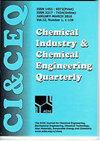花生浸炸过程能耗的优化
IF 0.8
4区 工程技术
Q4 CHEMISTRY, APPLIED
Chemical Industry & Chemical Engineering Quarterly
Pub Date : 2023-01-01
DOI:10.2298/ciceq230116018d
引用次数: 0
摘要
本研究旨在探讨花生浸泡分批油炸不同工艺条件对其比能量消耗的影响。调查通过模拟进行,其中使用不同的热功率/花生质量比计算能耗。根据所检查区域内应用的优化程序和计算数据,估计24 kW加热功率和28.6 kg花生所涉及的制度给出了最小的比能耗。此外,所得到的表面可以作为在更有利的能源效率制度下设计和操作油炸设备的基础。本文章由计算机程序翻译,如有差异,请以英文原文为准。
Optimization of energy consumption during immersion frying of peanuts
The objective of this study was to investigate the influence of different regimes of immersion batch frying of peanuts on its specific energy consumption. The investigation was conducted via simulation, where energy consumption was calculated using various heat power / peanut mass ratios. As the result of the applied optimization procedure within the examined domain and calculation data, it estimated that regime where 24 kW of heating power and 28.6 kg of peanuts were involved gave the minimum specific energy consumption. Besides that, the resulting surface could serve as a basis for designing and operating the frying equipment in more favorable regimes in terms of energy efficiency.
求助全文
通过发布文献求助,成功后即可免费获取论文全文。
去求助
来源期刊

Chemical Industry & Chemical Engineering Quarterly
CHEMISTRY, APPLIED-ENGINEERING, CHEMICAL
CiteScore
2.10
自引率
0.00%
发文量
24
审稿时长
3.3 months
期刊介绍:
The Journal invites contributions to the following two main areas:
• Applied Chemistry dealing with the application of basic chemical sciences to industry
• Chemical Engineering dealing with the chemical and biochemical conversion of raw materials into different products as well as the design and operation of plants and equipment.
The Journal welcomes contributions focused on:
Chemical and Biochemical Engineering [...]
Process Systems Engineering[...]
Environmental Chemical and Process Engineering[...]
Materials Synthesis and Processing[...]
Food and Bioproducts Processing[...]
Process Technology[...]
 求助内容:
求助内容: 应助结果提醒方式:
应助结果提醒方式:


